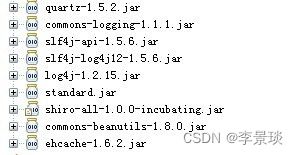Shiro应用到Web Application
一、权限基础
a) 认证(你是谁?)
判断你(被认证者)是谁的过程。通常被认证者提供用户名和密码。
常见的认证包含如下几种:
- 匿名认证:允许访问资源,不做任何类型的安全检查。
- 表单认证:访问资源之前,需要提交包含用户名和密码的表单。这是web application最常用的认证方式。这个过程一般会接合Session,只在第一次(新会话)访问资源时提交认证表单。
- 基本HTTP认证:基于RFC 2617的一种认证方式。
- 用户认证:Filter that allows access to resources if the accessor is a known user, which is defined as having a known principal. This means that any user who is authenticated or remembered via a 'remember me' feature will be allowed access from this filter.
b) 授权(你可以做什么?)
判断被认证者(你)是否能做什么操作的过程。
- 端口授权:必须通过指定的某个端口才能访问资源。
- Permission授权:Filter that allows access if the current user has the permissions specified by the mapped value, or denies access if the user does not have all of the permissions specified.
- Role授权:Filter that allows access if the current user has the roles specified by the mapped value, or denies access if the user does not have all of the roles specified.
perms org.apache.shiro.web.filter.authz.PermissionsAuthorizationFilter
port org.apache.shiro.web.filter.authz.PortFilter
roles org.apache.shiro.web.filter.authz.RolesAuthorizationFilter
ssl org.apache.shiro.web.filter.authz.SslFilter
c) 加密
使用技术手段(如:MD5、SHA等)把待加密的数据变为密文(如:信息摘要等)过程。
d) RBAC
基于角色的访问控制(Role-Based Access Control)。
e) Realm
data access object for an application’s security components (users,roles, permissions)
f) Permission
最小粒度的授权,不与用户关联。
例如:导出报表、查看id号为“PO20090008”的采购单、创建FAQ。
g) Role
Permission的集合。
二、Shiro特点
- 简单。
- 功能强大。
- 能独立运行,不依赖其它框架或容器。
- 包含了认证、授权、Session管理、加密。
- 易于扩展。
三、web application 集成Shiro
a) 数据模型
用户账号Account,可以简单的理解为用户。
一个账号可以拥有多个角色(Role)。
一个角色包含了多个权限(Permission)。
b) 创建工程,新建实体,添加与Shiro相关的Jar包
Eclipse:File--New--Other--Web--Dynamic Web Project
在 /WEB-INFO/lib/目录下添加如下Jar包
相关Jar包,http://incubator.apache.org/shiro/download.html
c) 配置web.xml,添加过滤器
ShiroFilter
org.apache.shiro.web.servlet.IniShiroFilter
ShiroFilter
/*
d) INI配置
[main]
#SHA256加密
sha256Matcher = org.apache.shiro.authc.credential.Sha256CredentialsMatcher
#realm
myRealm = com.xx.xx.shiro.MyShiroRealm
myRealm.credentialsMatcher = $sha256Matcher
#缓存
myRealm.authorizationCachingEnabled = true
cache=org.apache.shiro.cache.ehcache.EhCacheManager
myRealm.cacheManager=$cache
[filters]
shiro.loginUrl = /login.jsp
#authc=org.apache.shiro.web.filter.authc.FormAuthenticationFilter
authc.successUrl =/background.jsp
perms.unauthorizedUrl =/401.jsp
[urls]
/login.jsp=authc
/logout.jsp=anon
/about.jsp=anon
/background.jsp=authc
/faq/test.jsp=authc
/faq/list.jsp=authc,perms["faq:list"]
/faq/view.jsp=authc,perms["faq:view"]位置:
配置参数可以写在web.xml文件中,也可以单独文件形式存放在本地类根路径、文件系统以及网络环境中。
Shiro INI Inline Config 和External Config
public class MyShiroRealm extends AuthorizingRealm {
protected AuthorizationInfo doGetAuthorizationInfo(
PrincipalCollection principals) {
String username = (String) principals.fromRealm(
getName()).iterator().next();
if( username != null ){
AccountManager accountManager = new AccountManagerImpl();
Collection myRoles = accountManager.getRoles( username );
if( myRoles != null ){
SimpleAuthorizationInfo info = new SimpleAuthorizationInfo();
for( Role each:myRoles ){
info.addRole(each.getName());
info.addStringPermissions( each.getPermissionsAsString() );
}
return info;
}
}
return null;
}
protected AuthenticationInfo doGetAuthenticationInfo(
AuthenticationToken authcToken ) throws AuthenticationException {
UsernamePasswordToken token = (UsernamePasswordToken) authcToken;
String accountName = token.getUsername();
//用户名密码验证
if( accountName != null && !"".equals(accountName) ){
AccountManager accountManager = new AccountManagerImpl();
Account account = accountManager.get( token.getUsername() );
if( account != null )
return new SimpleAuthenticationInfo(
account.getName(),account.getPassword(), getName() );
}
return null;
}
} f) 登录页面
<%Object obj = request.getAttribute(org.apache.shiro.web.filter.authc.
FormAuthenticationFilter.DEFAULT_ERROR_KEY_ATTRIBUTE_NAME);
boolean flag = false;
String msg = "";
if( obj != null ){
if( "org.apache.shiro.authc.UnknownAccountException".equals( obj ) )
msg = "未知帐号错误!";
else if("org.apache.shiro.authc.IncorrectCredentialsException".equals( obj ))
msg = "密码错误!";
else if( "org.apache.shiro.authc.AuthenticationException".equals( obj ))
msg = "认证失败!";
flag = !"".equals(msg);
}
if( flag )
out.print( msg );
%>
g) 登出页面
<%SecurityUtils.getSubject().logout();%>四、在Shiro中实现CAPTCHA(验证码)功能
a) 验证码表单认证过滤器
import javax.servlet.ServletRequest;
import javax.servlet.ServletResponse;
import org.apache.shiro.authc.AuthenticationToken;
import org.apache.shiro.web.filter.authc.FormAuthenticationFilter;
import org.apache.shiro.web.util.WebUtils;
public class CaptchaFormAuthenticationFilter extends FormAuthenticationFilter{
public static final String DEFAULT_CAPTCHA_PARAM = "captcha";
private String captchaParam = DEFAULT_CAPTCHA_PARAM;
public String getCaptchaParam() {
return captchaParam;
}
protected String getCaptcha(ServletRequest request) {
return WebUtils.getCleanParam(request, getCaptchaParam());
}
protected AuthenticationToken createToken(ServletRequest request, ServletResponse response) {
String username = getUsername(request);
String password = getPassword(request);
String captcha = getCaptcha(request);
boolean rememberMe = isRememberMe(request);
String host = getHost(request);
return new CaptchaUsernamePasswordToken(username, password, rememberMe, host,captcha);
}
}b) 用户名密码令牌UsernamePasswordToken
import org.apache.shiro.authc.UsernamePasswordToken;
public classCaptchaUsernamePasswordToken extends UsernamePasswordToken {
private static final long serialVersionUID = 1L;
private String captcha;
public String getCaptcha() {
return captcha;
}
public void setCaptcha(String captcha) {
this.captcha = captcha;
}
public CaptchaUsernamePasswordToken() {
super();
}
public CaptchaUsernamePasswordToken(String username, char[] password,
boolean rememberMe, String host,String captcha) {
super(username, password, rememberMe, host);
this.captcha = captcha;
}
}c) 添加AuthenticationException
public classIncorrectCaptchaException extends AuthenticationException{
private static final long serialVersionUID = 1L;
public IncorrectCaptchaException() {
super();
}
public IncorrectCaptchaException(String message, Throwable cause) {
super(message, cause);
}
public IncorrectCaptchaException(String message) {
super(message);
}
public IncorrectCaptchaException(Throwable cause) {
super(cause);
}
}d) Shiro INI文件
authc= com.xx.xx.shiro.CaptchaFormAuthenticationFiltere) 实现Realm
protectedAuthenticationInfo doGetAuthenticationInfo(
AuthenticationToken authcToken ) throwsAuthenticationException {
CaptchaUsernamePasswordToken token = (CaptchaUsernamePasswordToken) authcToken;
String accountName = token.getUsername();
//验证码 验证
String captcha = null;
Object obj_captcha = SecurityUtils.getSubject().getSession().getAttribute( SessionKey.CAPTCHA );
Object obj_count = SecurityUtils.getSubject().getSession().getAttribute( SessionKey.LOGIN_FAILED_COUNT );
int failed_count = (obj_count == null || !(obj_count instanceof Integer))?0:(Integer)obj_count;
if( obj_captcha instanceof String)
captcha = (String)obj_captcha;
if( captcha != null && failed_count >0&& !captcha.equalsIgnoreCase( token.getCaptcha() )){
throw newIncorrectCaptchaException("验证码错误!");
}
//用户名密码验证
if( accountName != null && !"".equals(accountName) ){
AccountManager accountManager = newAccountManagerImpl();
Account account = accountManager.get( token.getUsername() );
if( account != null )
return new SimpleAuthenticationInfo( account.getName(),account.getPassword(), getName() );
}
return null;
}
}f) 登录页面
<% Object obj = request.getAttribute(org.apache.shiro.web.filter.authc.
FormAuthenticationFilter.DEFAULT_ERROR_KEY_ATTRIBUTE_NAME);
boolean flag = false;
String msg = "";
if( obj != null ){
if( "org.apache.shiro.authc.UnknownAccountException".equals( obj ) )
msg = "未知帐号错误!";
else if("org.apache.shiro.authc.IncorrectCredentialsException".equals( obj ))
msg = "密码错误!";
else if("com.xx.xx.shiro.IncorrectCaptchaException".equals( obj ))
msg = "验证码错误!";
else if( "org.apache.shiro.authc.AuthenticationException".equals( obj ))
msg = "认证失败!";
flag = !"".equals(msg);
}
if( flag ){
out.print( msg );
Integer count = (Integer)request.getSession().getAttribute(SessionKey.LOGIN_FAILED_COUNT );
if( count == null )
count = Integer.valueOf(0);
count++;
request.getSession().setAttribute(SessionKey.LOGIN_FAILED_COUNT, count);
}
%>
用户帐号:
登录密码:
验证码:

g) CAPTCHA实现
h)
五、代码的开发环境
JAVA1.6
Tomcat
Eclipse

